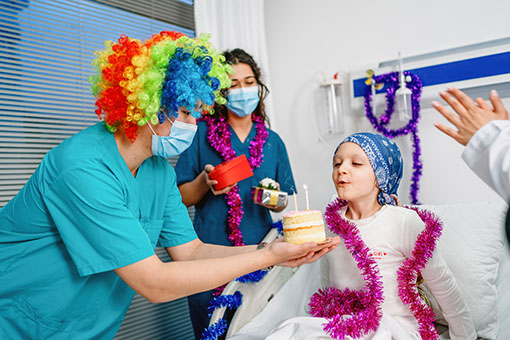Prognosis and long-term outlook
Paediatric Chordoma Guide
The end of successful treatment and the prospect of returning home from hospital can raise conflicting feelings. You are all likely to feel a sense of relief that you can return to the comfort of your own home. However, it might take some time for your child to transition back into everyday life after a long time in hospital.
You as parents might also struggle in the transition home. You might feel anxious about leaving behind the reassurance provided by hospital staff about your child’s progress. You might find yourself living with a heightened concern about any symptoms your child has, and whether there may be signs of their cancer returning.
This is all very common. Remember, you and your child will have regular follow-up appointments and the hospital team will be on hand to answer any questions or address any worries you might have.
How your child will do following treatment is something that doctors cannot accurately predict. Statistics tell us the average outcome if you study a large number of patients with the same condition. Due to the rarity of paediatric chordoma, meaningful statistics are very challenging to achieve.
Besides, statistics are only helpful to a degree – they can’t say what will specifically happen with your child. Every child is different and will respond to treatment in a different way.
However, we do know some things. We know that, overall, the prognosis of paediatric chordoma is better than that of adult chordoma.
Words in bold are explained in a glossary.
Paediatric Chordoma Guide

Doctors are also aware more generally of which children with chordoma might do better or worse than others. There are certain factors which are known, to some degree, to influence the chance of recovery. These include:
Type of chordoma: INI-1-negative chordomas (most of which are poorly differentiated and dedifferentiated chordoma) are generally more difficult to treat successfully than other types
Age at diagnosis: the poorest outcomes are generally seen in children under 5 years of age
The amount of cancer cells remaining following surgery: the removal of the cancer must be as complete as possible to improve the outcome
- Whether the cancer spreads elsewhere in the body: this is more common in children under 5 years of age
The above suggests that, unfortunately, children that develop chordoma under 5 years of age are less likely to do quite so well as older children. It is important, though, to remember that your child is an individual and may not necessarily follow the outcome expected.
As you walk this path and inevitable concerns and questions are raised in your mind, please speak to a member of the team caring for your child – they are there to give you advice, support and information to make the decisions needed.
